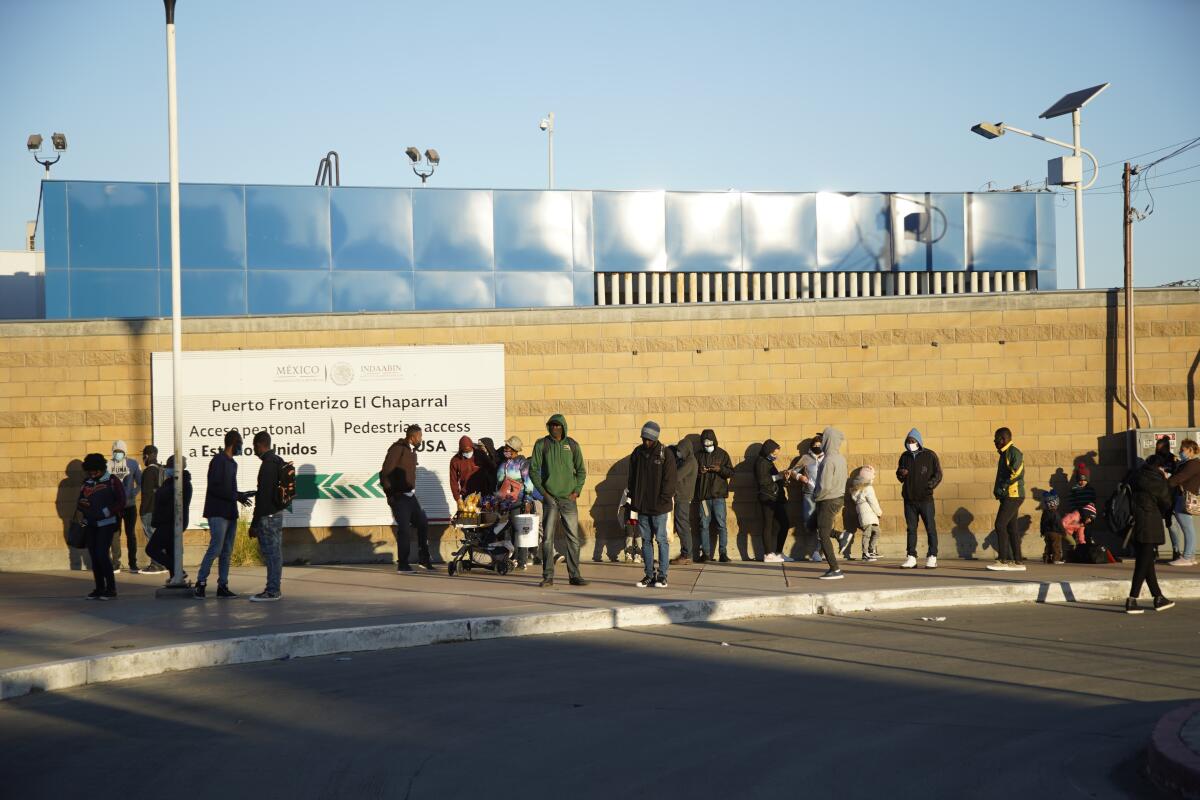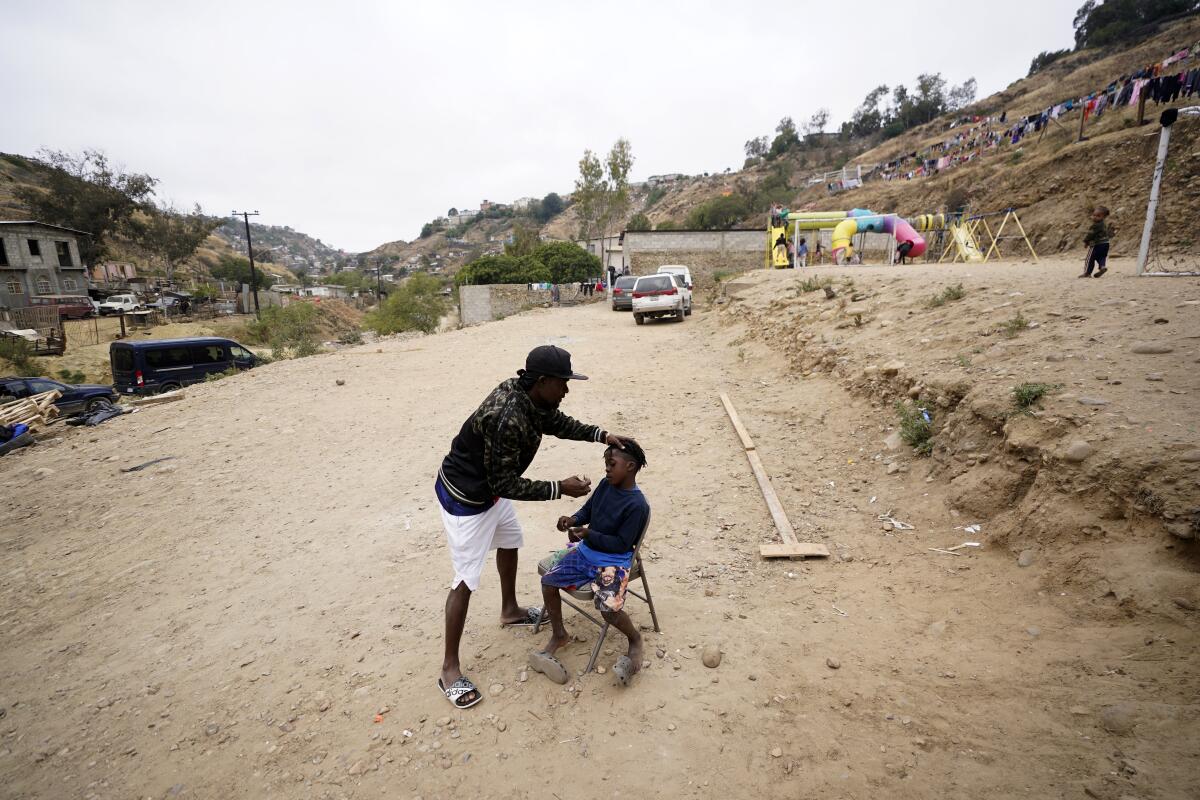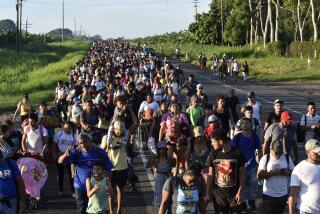First confusion, and finally some relief, as ‘Remain in Mexico’ begins to wind down in San Diego

- Share via
Moments after his immigration case was heard Wednesday, a 51-year-old Cuban asylum seeker sat on a bench in the back of the courtroom and wept openly.
He had just learned that he would be allowed to fight his case from inside the United States instead of returning again to Tijuana under the “Remain in Mexico” program.
He’d been waiting more than two months in Tijuana for his immigration court case under the program, known officially as Migrant Protection Protocols.
“In this moment, I am free,” he told the Union-Tribune in Spanish a few minutes after he was officially released from custody. “Before, I was not free.”
The man was among the first migrants released from MPP this past week with the Biden administration’s announcement that the program was ending, following a lengthy legal battle in federal court. However, days later, most of those enrolled in the program are still waiting to be let into the United States.
The long-anticipated and yet abrupt end to the program meant confusion on the first days — not only for the migrants themselves but also for those who work in the program, including immigration judges, private and government attorneys, and even the contracted guards who keep MPP enrollees in custody while they’re in U.S. immigration court.
This marks the Biden administration’s second attempt to end the Trump-created policy. Following a campaign promise, President Biden early on in his term terminated the program. Then after a lawsuit in Texas, his administration was ordered to reimplement it. This second wind down comes after the U.S. Supreme Court ordered in June that the administration could end Remain in Mexico.
But the administration didn’t act on the Supreme Court ruling until Monday, when the district court that had initially ordered the program’s reimplementation officially vacated its decision. The Department of Homeland Security announced hours later that people would be unenrolled when they came onto U.S. soil for their next court hearings.

This process is different from the previous wind-down, which involved coordination among international agencies and local nonprofits to bring dozens of asylum seekers into the U.S. each morning.
So far one to three people per day have been taken out of the program in San Diego for a total of eight since Tuesday. At that pace, the wind-down could take months to bring in the hundreds waiting in Tijuana.
In contrast, when the Biden administration initially ended the program in 2021, 25 people were brought into the United States at the San Diego-Tijuana border just on the first day, according to Jewish Family Service, a local nonprofit that assisted in welcoming the asylum seekers onto U.S. soil.
Homeland Security did not respond to questions about the speed of the current process.
Immigration officials responded to the arrival of Ukrainian asylum seekers at the border in the spring at a far faster rate.
In April, border officials in San Diego were able to receive more than 300 Ukrainian asylum seekers per day at the San Ysidro Port of Entry. If Homeland Security chose to move at a similar pace for the MPP wind-down, all of those waiting in Tijuana for their next hearings could be inside the United States within a couple of days.
With little clarity about what the disenrollment process would look like, Monday’s announcement left many in Tijuana anxious about whether they might end up in U.S. immigration detention. Recently, that started happening to many people who were initially enrolled in the program but later passed screening interviews that found they were in danger in Mexico and should not be returned.
That question remained after the first day of post-MPP hearings.
On Tuesday, Michael Sullivan, an attorney representing the U.S. government, told Immigration Judge Catherine Halliday-Roberts that the two men before her would be disenrolled in the program and not returned to Tijuana. But he did not know whether they would be detained in long-term custody or released to their families.

An official with Immigration and Customs Enforcement, which makes immigration custody determinations, later confirmed that the two men were ultimately taken back to the port of entry and then released with alternatives-to-detention devices to monitor their locations within the U.S.
Since then, all of the other MPP enrollees who have crossed the border this past week have ended up at the San Diego Rapid Response Network Migrant Shelter, where they were tested for COVID-19 before getting help traveling to their final destinations around the country.
Knowing that people so far are being released exacerbates the frustration felt by former MPP enrollees who were able to get out of the program before its end, only to be detained by ICE.
Kirsten Zittlau, a San Diego attorney who has taken many MPP cases, said she’s getting calls from her detained clients who used to be in MPP asking how the end of the program affects them. It doesn’t, she tells them.
“It’s just a really raw deal for them,” she said. “It was just a matter of timing whether they were detained or let in. It’s just ridiculous.”
When asked about their situations, an ICE official said that the agency makes custody determinations on a case-by-case basis.
But for people such as the man from Cuba who are now finding themselves able to reunite with family already in the United States — in his case a U.S. citizen brother in Florida — the moment is life-changing.
The man is not being identified because of concerns about the safety of family still in his home country.
He was the only person who had an MPP hearing on Wednesday. Two guards stood watch as he listened intently to a court interpreter who relayed the court proceedings to a headset that he wore.
Judge Halliday-Roberts asked ICE attorney Jennifer Woodmansee, who appeared along with the man’s attorney via video screen, what would happen to the man in light of the program’s end.

“He is not going to be detained, and he will not be removed to Mexico,” Woodmansee said, asking the court to transfer his case to Orlando to be closer to his new home.
The man filled out his change of address form with his brother’s address from memory, though he pulled a crumpled piece of paper from his pocket to double check it once finished.
“Sir, I wish you well,” Halliday-Roberts told him. She asked if he had any final questions before the case adjourned for the day.
“No,” the man responded, “Only to say thank you for allowing me to enter into your country.”
The judge tried to explain that it hadn’t been her decision, but the man didn’t seem to care. He offered his thanks to everyone in the courtroom and on the video screen. Once the case was over, his attorney asked him to call as soon as he was able — his attorney still didn’t know how or where he would be released.
When the man returned to a bench in the public seating area of the courtroom, his eyes were already red. He briefly removed his mask and sobbed before turning to apologize to the observers in the room.
Guards took the man to a small room and allowed staff members from Jewish Family Service, which operates the San Diego Rapid Response Network Migrant Shelter, to speak with him. While they were talking, a plainclothes ICE officer came out of the elevator, asked the man a couple of questions, and then told the guards they could leave. The man was no longer in their custody.
He was overwhelmed — a mix of nervousness, anxiety, excitement and joy, he said. He hadn’t known what to expect when he came to the border for court early that morning.
“They closed [MPP], but we never clearly knew anything,” the man said. “Today we’re learning the process.”
Now that he is free on U.S. soil, after one year, he will be able to apply for a green card through a special program only for people from Cuba. Then he will be able to sponsor his wife and children, whom he left behind in Cuba.
“Knowing that I will be able to be here is huge,” he said. “It’s magnificent.”
More to Read
Sign up for Essential California
The most important California stories and recommendations in your inbox every morning.
You may occasionally receive promotional content from the Los Angeles Times.











